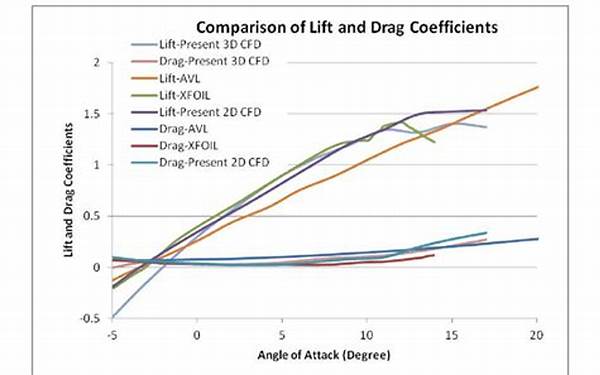Hey there, fellow aviation enthusiasts! Today, we’re going to dive into the fascinating world of aerodynamics, specifically looking at lift and drag coefficients in predictions. Whether you’re a seasoned engineer or just someone who’s curious about how planes stay up in the sky, you’ll find something interesting here. These coefficients are kind of like the secret sauce that helps us predict how an aircraft will perform, and they’re absolutely essential for ensuring safe and efficient flight. So, let’s get started!
Read Now : Classic Golf Clothing Styles
Understanding Lift and Drag Coefficients
When we talk about lift and drag coefficients in predictions, we’re essentially discussing how we can anticipate an aircraft’s performance even before it takes to the skies. Lift, as you might know, is the force that keeps things aloft. Meanwhile, drag is the opposing force that slows everything down. Calculating these coefficients involves a lot of math and physics, but don’t worry, we’re keeping things casual here! Think of lift and drag coefficients as the way engineers predict how an aircraft will handle air resistance and generate enough lift to stay up. These predictions help in designing wings and other components to optimize performance and fuel efficiency. By using these coefficients wisely, we make flying not just possible, but smoother and safer for everyone.
The Importance of Accurate Predictions
1. By understanding lift and drag coefficients in predictions, engineers can design more efficient aircraft.
2. These coefficients help predict how much fuel a plane will need for certain distances.
3. Accurate predictions can prevent costly redesigns by getting things right the first time.
4. Predicted coefficients ensure aircraft can handle varying weather conditions safely.
5. They offer insights into how modifications might affect overall performance.
Real-World Applications of Lift and Drag Coefficients
In our everyday world, lift and drag coefficients in predictions are more relevant than you might think. For instance, when new aircraft are being designed, these coefficients are key to predicting how they’ll perform in real-life conditions. Think about it: planes have to operate safely and efficiently through all sorts of weather conditions, which means the math behind these predictions has to be spot-on. By using advanced software and wind tunnel testing, engineers can foresee how changes in design will impact an aircraft’s lift and drag. This anticipation game allows for smarter, more thoughtful engineering decisions, making our flights not only safe but also as sleek and efficient as possible.
How Lift and Drag Coefficients Influence Design
1. Lift and drag coefficients in predictions directly affect the shape of wings designed for optimum performance.
2. By analyzing these coefficients, materials used for the aircraft can be selected to balance weight and strength.
3. Engineers can predict maintenance needs, improving aircraft longevity.
4. Understanding these predictions helps in noise reduction efforts, making aircraft more environmentally friendly.
Read Now : “digital Golf Swing Analysis”
5. It supports engineers in developing technologies for new eco-efficient engines.
6. Lift and drag coefficients in predictions play a crucial role in simulation and training pilots.
7. Insights from these predictions assist in emergency preparedness, enhancing safety protocols.
8. In racing and sports aviation, they inform strategies for speed and maneuverability.
9. Predictions based on these coefficients are essential for drone and UAV design.
10. They also support the development of futuristic flying vehicles, like flying taxis!
Challenges in Accurate Predictions
While discussing lift and drag coefficients in predictions, it’s crucial to also talk about the challenges involved. As much as we’d love to rely solely on mathematical models, real-world variables turn this into a more complex affair. Wind conditions, air density, and even unexpected turbulence can throw off calculations. Hence, accuracy remains a moving target. Engineers often rely on both computational simulations and wind tunnel tests to refine their models. These methods, although powerful, aren’t flawless and must constantly evolve to enhance prediction reliability. Yet, this pursuit of precision is what ultimately leads to safer skies and more efficient air travel.
Future Trends in Aerodynamic Predictions
Looking forward, lift and drag coefficients in predictions will continue to shape the future of aviation. With advancements in AI and machine learning, these calculations are poised to become even more accurate, allowing for innovations in aircraft design that we can only dream of right now. Imagine planes that are lighter, faster, and burn significantly less fuel, all thanks to precise aerodynamic predictions. The integration of these advanced technologies means we’re standing on the brink of a new era in air travel—one that’s smarter, greener, and more efficient. So, buckle up, the future of flight is looking incredibly exciting!
Summary of Lift and Drag Coefficients in Predictions
So, there you have it—a breezy walk through the essentials of lift and drag coefficients in predictions. In essence, these coefficients are the backbone of modern aerodynamic engineering. By helping predict and understand how an aircraft will handle its environment, they guide design choices and performance enhancements. The ever-evolving science behind them continues to pave the way for groundbreaking advancements in air travel, setting the stage for a future that blends efficiency with innovation. Whether it’s making planes quieter, faster, or more fuel-efficient, it all starts with getting those lift and drag numbers just right. As we continue to push the frontiers of this field, the sky, quite literally, is the limit!
